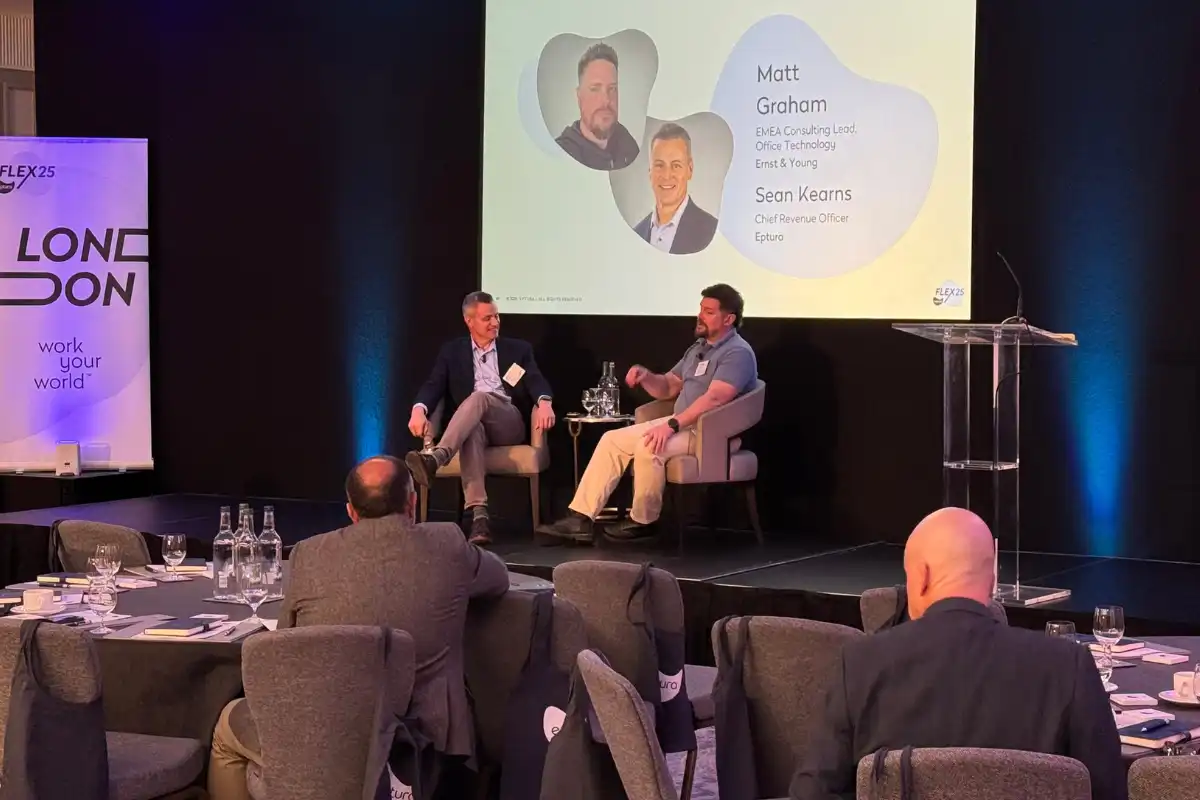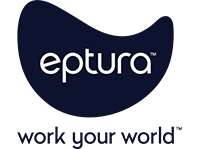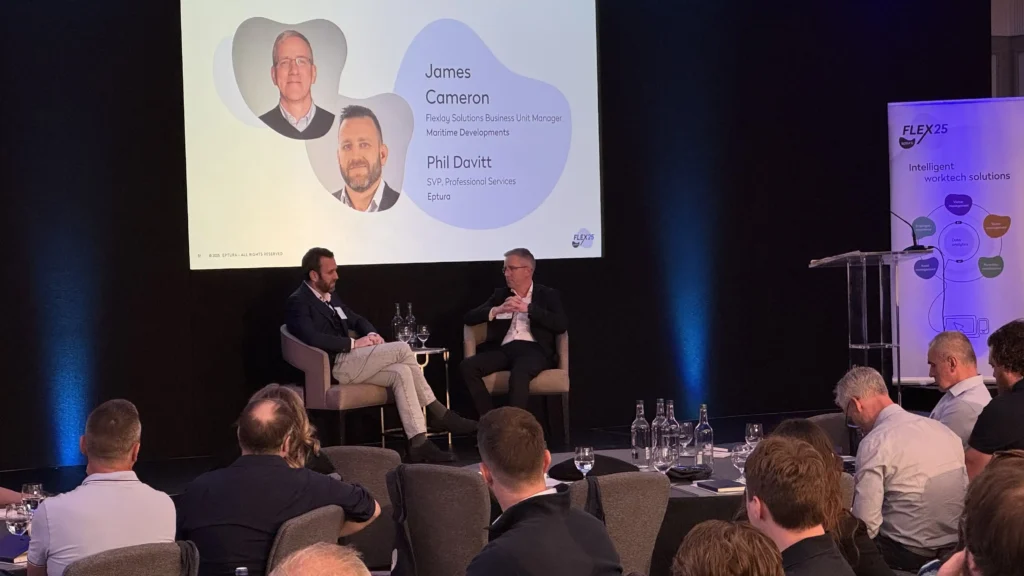
Flex/25 London brought workplace and operations leaders from across the UK and Western Europe together for a day of best practices, collaboration, and actionable insights. Now in its third year, the 2025 event took place on May 13 at the Biltmore Mayfair and drew organizations from the business services, insurance, and legal segments (47% of attendees), followed by those in accounting, banking and finance (27%) and technology, communications or entertainment (22%).
While attendees represented a wide cross-section of industries, they shared a clear collective priority: enhancing employee experience and operational efficiency in the workplace.
Employee experience and the rise of the digital workplace leader
In his keynote address, Eptura CEO Brandon Holden started by looking at common goals for facility and workplace leaders. He highlighted that to deliver an ideal workplace, organizations must:
- Create frictionless experiences for employees
- Navigate return to office
- Gain visibility across real estate portfolios
- Optimize facility performance
- Find efficiencies and drive cost savings
- Set the foundation for future AI
He also shared research identifying the current trends that make reaching these goals more challenging. According to Eptura’s 2025 Workplace Index report, 34% of organizations plan to increase the number of in-office days in 2025, and a growing number of those returning employees are part of an important demographic shift: Gen Z employees are already 18% of the workforce but are forecast to grow to over 20% in the next five years. These trends mean increased urgency for workplace and facility leaders to find opportunities to improve space optimization, operational efficiency, and employee engagement.
In the same report, Holden explained, there are clear signs the industry is embracing AI-backed data analytics and automation to deliver a strong employee experience. He noted that employee experience is now seen as the area for digital transformation with the highest potential to drive value. By becoming more connected, operational leaders can utilize data analytics across multiple business functions to get the insights they need to make more informed decisions and find the optimal balance between employee experience and space usage. He also pointed to the growing number of companies with digital workplace leaders, highlighting a widespread commitment to investing in digital transformation.
Employee experience starts with measuring the right metrics, including some new ones
Madi Hanc, a senior researcher from UnWork, delivered a thought-provoking presentation on the importance of good utilization data when developing workplace strategy. She stressed the importance of gathering data on how the office is being used before implementing return-to-office policies, citing many of the high-profile cases, including Amazon, where managers mandated RTO with insufficient data, leading to a shortage of desks.
Reaching organizational goals is a multi-step process, and Hanc outlined the progression from capturing data to supporting overall productivity:
- Understand how employees use the office
- Understand employee needs
- Optimize space costs
- Improve employee experience
- Improve productivity
After reviewing case studies where UnWork used combinations of more traditional data sources to track utilization, Hanc challenged the audience to explore a new metric, office vibrancy. By measuring the energy and engagement within the workspace, organizations have a more holistic measure of success, and that in turn helps them create environments that not only optimize space but also foster a sense of community and collaboration.
The importance of good metrics was echoed by Matt Graham, EMEA consulting lead for office technology from EY, in his fireside chat on the role of technology in enabling smarter workplaces. Graham highlighted the importance of utilization and occupancy as real estate and facility management metrics, making sure to distinguish between the two. Occupancy is the number of people through the door, while utilization is how effectively people are using the space.
Like Hanc, Graham also encouraged the audience to consider experience indices like the demographics of the people using the space, to gain a more comprehensive understanding of workplace dynamics. By finding new ways to look at their spaces and how people use them, organizations can better meet the needs of their employees.
The challenges of data capture are not always technical. In fact, some considerations are more emotional. When Graham was asked about managing workplace technology across global regions, he emphasized the importance of privacy and data protection for employees. While data is essential for creating a more efficient and personalized employee experience, some are reluctant to provide what they feel is too much information.
Phil Davitt, senior vice president professional services at Eptura, more generally addressed the issues that come with gaining buy-in when unifying workplace operations during an interactive workshop. Davitt facilitated a structured discussion for attendees to collaborate on how to tailor approaches based on functions and consider benefits, standards, and meaningful metrics.
The promise of AI depends on clear goals, connected data
According to the 2025 Workplace Index report, many facility and workplace professionals have plans to implement AI in key building and facility operational areas, including:
- 77% Employee experience
- 68% Visitor management
- 59% Space optimization
In his presentation on the transformation of the workplace through AI, Andy Targell, global head of real estate technology advisory at JLL Technologies, covered some of the recent developments in the field and how they directly related to real estate and facility management.
Working from business goals and tangible use cases
He categorized AI into three main types:
- Generative AI: Tools like ChatGPT that can create content and responses
- Predictive AI: Technologies that forecast trends and outcomes
- Optimizing AI: Including agentic AI, which can take actions previously requiring human intervention
For corporate real estate, he divided AI tools into enterprise-level AI, which includes large language models and AI plugins for CRM systems, and CRE-specific AI, tools that cover areas like capital projects, portfolio management, and building operations.
While he presented many tangible use cases, including location strategy, portfolio optimization, and employee experience, he also stressed the importance of aligning technology with business goals like revenue growth, cost control, safety, sustainability, efficiency, and worker productivity. Setting clear business goals and exploring concrete use cases is essential to realizing the true value of AI and avoiding the pitfalls of generic, complex solutions.
“Technology follows your goals, not the other way around,” he explained.
Setting a foundation with connected data
The challenges of data silos and the power of connected data were a recurring topic at the event.
John Hilderbrands Eptura VP, channel and alliance solutions, opened his presentation with revealing stats from the Workplace Index report. When asked, “What are the biggest challenges you face when analyzing your organizational data?” 58% responded “Multiple data dashboards” and 55% said it was “Length of time to accumulate meaningful data across different software solutions.”
Susan Clarke, senior manager, building operations industry strategy at Autodesk, emphasized that while we’re firmly in the era of Big Data, the next step is AI. However, the value of AI depends not just on the amount of data, but on how well that data is structured and connected.
The challenge is that so many companies currently operate with disconnected systems. There should be a “digital thread” connecting systems and teams across planning, design, construction, and operations, she said, but instead companies have a “digital spread,” she explained.
Clarke positioned Autodesk’s partnership with Eptura as a strategic effort to bridge these gaps and enable a unified digital asset lifecycle — from design through to operations. She argued that to truly benefit from AI, organizations must start with the outcomes they want to achieve. That means defining the information needed from the outset and ensuring it’s structured in a way that supports automation and insight.
She shared a compelling example from a customer who found over ten different naming conventions for the same asset across 300 projects — highlighting the need for standardization. Without consistency, AI risks learning from bad habits rather than delivering meaningful insights.
Clarke advised organizations to find answers to foundational questions, including:
- What decisions are we trying to support?
- What data do we need?
- Where is it stored?
- Is it standardized?
With the right data strategy in place, she believes the industry can unlock smarter, more sustainable outcomes.
In his presentation on building information modeling for facility management (BIM for FM), David March, senior vice president solutions engineering at Eptura, spoke about the challenges and rewards of connecting data from across the building lifecycle. With the right data, policies and procedures, organizations can implement, for example, parts killing, asset hierarchies, tool tracking, and stronger work order management. He also highlighted a key asset maintenance productivity gain from AI analytics and automation: Preventive maintenance work orders take roughly half as much time as reactive work.
Connected data success story
In a fireside chat, James Cameron, interviewed by Phil Davitt, shared valuable insights on what it takes for MDL to maintain undersea assets. MDL has grown from one person fixing fishing winches into £45M business with 50 people offshore managing critical assets that enable installation and recovery of subsea equipment. The company’s mantra “can’t allow downtime” highlights the importance of reliability in their business. Cameron explained that implementing Eptura Asset has been instrumental in helping them reduce administration and information delays by moving maintenance management away from Word documents, understanding downtime before issues arise, and quickly discerning business cases for capital investment. A proactive approach to asset management and maintenance has allowed them to stay ahead of potential issues, ensuring continuous operation and minimizing disruptions.
For those starting with a new maintenance management system, Cameron recommended fixing data before it’s imported by defining what the data fields and categories should b. His team wrote a CMMS manual of fields and definitions, starting with the information that was most important to the business and growing from there.
The vision for a unified workplace
Kev Jones, vice president of product management at Eptura, shared Eptura’s vision for intelligent worktech to connect employee experience, visitor management, space and asset management, portfolio optimization, and data analytics. With the use of AI-powered features like intelligent booking for individuals and teams to foster in-office attendance, organizations can elevate productivity and collaboration and create workplaces where employees can do their best work.
His message echoed the key insight from the Workplace Index report: The solution isn’t more tech. Companies say they already have too many systems, creating data silos they can only partially connect through inefficient spending on time and talent. In fact, 37% of organizations need 11 or more full-time employees to collate, analyze, and report on their worktech data. Organizations need a unified system that unlocks data analytics and supports embedded AI.








